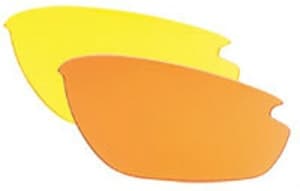Ever wonder if there was a pair of shooting glasses with a color able to suit every single need you had? A pair of glasses tinted with the right color can drastically enhance the shooter’s experience, but unfortunately, there is no one such color for every situation. Lenses are colored differently so they can be specific towards varying situations. Whether you are trap shooting or scanning the brush for a buck as dusk draws near, colored lenses help make the job easier.
What Are My Eyes Seeing?
Breaking it down from the top, it would help to make a quick rundown of what we see as color. In reality, the color spectrum is far wider than the few solid colors we see on a daily basis. When the sun is out, all the colors and hues in a rainbow are present and all around us, but we just see what is being reflected and absorbed. The spectrum goes from long wavelengths to shorter ones. Both ends of the spectrum are invisible to the naked eye, but in the middle lies the colors of the world visible to our eyes. For example, a clay pigeon is orange because it reflects back red and orange wavelengths while effectively absorbing all other colors.
The point of tinted lenses is to protect our eyes from harsh UV rays and to filter out the wavelengths of light we don’t need to see. Shooting lenses are a very popular thing to wear as they not only offer protection to a shooter’s most valuable asset, but they also act as barriers to outside elements and obstacles. Those that are partaking in a casual weekend of shooting may choose the simple eye protection lenses readily available at the local hardware store, but other than the obvious protection it offers the eyes, the benefits really end there. Not only are they plastic, but there is no performance enhancing traits to be had with clear lenses.
To start off, If you want a serious pair of shooting lenses, then polycarbonate is the material you want them to be made out of. The lenses certified by the American National Standards Institute proves that those certain lenses have undergone multiple sessions of impact resistance testing. They are lightweight, extremely durable, and scratch resistant. If you want the real deal, look for the certification mark.
How Colors Help Me?
 Getting into the actual application for the color, we will start off with trap shooting. For this situation, color hues of orange and yellow would be the best. Not only do they block out haze and blue light but they intensify the color of the orange clay pigeon. Orange is the go-to for clay shooting but yellow is applicable as well. A lighter shade of yellow lens is most effective when used during overcast or when the light is low. Solid yellow is better fitted for rifle and pistol target shooting in darker conditions as it works well to contrast colors sitting close to opposite sides of the spectrum.
Getting into the actual application for the color, we will start off with trap shooting. For this situation, color hues of orange and yellow would be the best. Not only do they block out haze and blue light but they intensify the color of the orange clay pigeon. Orange is the go-to for clay shooting but yellow is applicable as well. A lighter shade of yellow lens is most effective when used during overcast or when the light is low. Solid yellow is better fitted for rifle and pistol target shooting in darker conditions as it works well to contrast colors sitting close to opposite sides of the spectrum.
If you were shooting clays in a greener setting, then purple or vermillion tints are what you’re looking for. Vermilion is perfect if you’re throwing clays towards a sea of green. It dampens anything green while enhancing orange. Light purple does the same but also dampens the color blue. Dark purple is perfect for environments that are extremely bright. Whether the clay is flying towards a deep blue sky or low atop the fresh snow, the glasses will serve to keep the glare out of your eyes and kill off any extra brightness.
For a different sort of scenarios, such as hunting or target shooting, there are a few colors that can cover the job. Sunset orange is best used for hunting in bright and hazy conditions as it utilizes scattered waves of blue for added contrast. Pale yellow tinting is meant to contrast colors and make what you’re seeing brighter in low light settings. These attributes work for both indoors and out. Brown shades are most popular amongst bird hunters as it reduces the glare and overall lighting extremely well, making looking up on a clear blue sky no problem at all. Ranger bronze shades are meant to be used on terrains where nothing is going on, such as the desert. These are a favorite for people hunting in the snow or desert.
Gray tinted lenses are completely neutral and do not enhance your clay pigeons orange shine or black and white paper targets. They do help with keeping an overbearing sun out of your eyes, however. Blue is a very special tint in the sense that it is meant to highlight green and not much else. It is not effective for blocking out the sun, dampening distracting colors, or keeping your clay orange enough to see, but just enhances the color green.
Where Can I Get a Pair of Shooting Lenses?
Below will be a few different glasses that can be found on Amazon. Armed with the information above, you can feel confident in your purchase of a pair of tinted lenses.
Color Lenses Final Thoughts
Shooting glasses give people a chance to enhance their shooting experience by gaining an edge. Whether they’re at the range or on a field beading a clay pigeon, they offer some distinct features that can make a huge difference in one’s shooting quality. Hopefully the information above gives you enough information to browse through the list of products complied with confidence to find just the right lens for your situation. There is no one lens tint to solve everything, but whatever you pick, be sure it fits what you need it to.
Footnotes:




